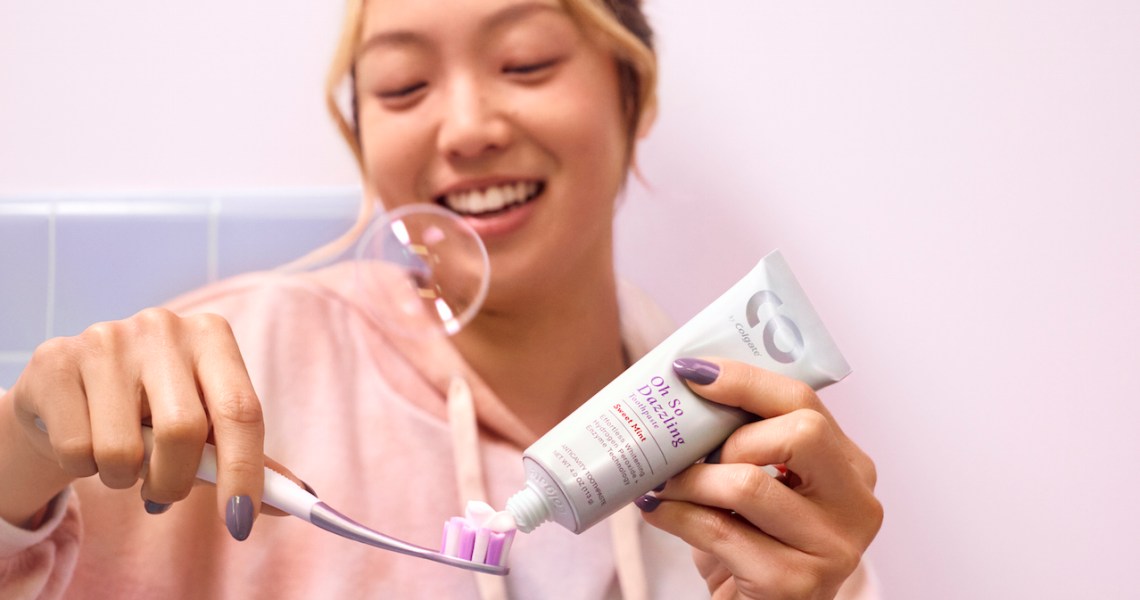Colgate-Palmolive, the 215-year-old CPG company, is going after younger consumers through toothpaste.
On March 19, it launched a new Gen-Z oral care brand called Co. by Colgate. It is sold exclusively through Ulta Beauty and the brand’s DTC e-commerce site. Reinventing toothpaste is a bit like reinventing the wheel or the pencil, which is to say that the perfect product cannot be improved. Yet, oral care brands have been crafting a new marketing persona for what is effectively a health care product, referring to the category as “oral beauty” despite a lack of new products.
Colgate internally incubated the new brand, comprised of 12 employees, in less than a year, said Liz Suspanic, brand manager in the Oral Care Innovation division. It includes seven items priced $8-$129: a sweet mint-flavored toothpaste called “Oh So Dazzling” in a shiny silver tube, an electric and manual toothbrush in a pink ombré travel case, on-the-go teeth whitening pens and kit, and an anti-stain foaming mouth wash called “Later, Stains!”
“What we’re trying to do is tap into every moment that this generation is looking for and meet their needs where they are throughout the whole seven-product collection,” said Suspanic. “This generation is attuned to mental health and self-care. When you’re looking at oral beauty, there is an element of merging the lines of oral care with self-care. This generation does see beauty as a way to fulfill the self-care needs.”
There is some basis for this shift. Cosmetic dentistry has continued to gain in popularity in the social media era. And young people are particularly susceptible: A study from 2019 of 3,000 8- to 12-year-old kids showed that a top dream job for U.S. children is to become a “vlogger or YouTuber.” Yet there has not historically existed an oral care brand or products marketed to teenagers the way there is for children or adults, though other brands from Moon to Rael personal care have begun to strike upon this notion. The pandemic has become a bright spot for the oral beauty category, as well. According to Euromonitor data, Colgate-Palmolive ranked No. 2 in U.S. toothpaste sales in 2019 and has 33.4% of toothpaste market share behind P&G’s Crest brand.
Dana Medema, Colgate- Palmolive vp and gm, said Colgate took multiple generational shifts into consideration when building Co. by Colgate. Among them were the types of foods that Gen Zers and Zoomers (those on the cusp of the Gen Z and millennial generations) are eating, where they’re shopping and what they value in brands. Co. plans to donate a portion of sales to charitable endeavors, but the details have not been finalized.
“We tried to design with this target demographic in mind: What are they doing, and how are they living?” said Medema. “[For example], we’re finding that [people are using] the whitening wand to get social ready or date ready.”
Ad position: web_incontent_pos1
To develop Co. by Colgate, the team worked with Gates Creative agency, as opposed to its agency of record WPP. Gates Creative has worked with Paula’s Choice, Rare Beauty and Fenty Beauty. The DTC website features UGC how-to videos on using the products. The brand, which developed Instagram, Facebook, YouTube and TikTok accounts from the outset, was previously developing its influencer strategy called “Co.llective,” that centers on four people, including Eunice Chan, 21 (@NotCheetos; 104,000 Instagram followers), and Cassandra Daly, 21 (@ViaCassie; 5,000 Instagram followers). It was featured on the DTC website and on social channels, but is no longer active, a Colgate spokesperson said.
Colgate-Palmolive also owns toothpaste brand Tom’s of Maine, and it acquired Hello Products in Jan. 2020 to consolidate its hold on the natural toothpaste category. Hello is also sold through Ulta Beauty. Medema said that the brand operates separately from the rest of the portfolio, so there is no concern of sales cannibalization.
Co. by Colgate might eventually expand beyond Ulta Beauty, Medema said, but only to other retailers popular with Gen Z and millennials, such as the Target and Ulta Beauty shop-in-shops. She declined to state first-year sales expectations, but said the goal in the first year is to understand the customer demographic better.
“We want to start a conversation,” she said. “We want to understand and get real feedback from this group of people and to be able to pivot, fix products or communication, and lean in.”




